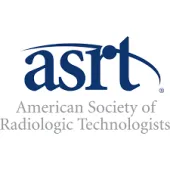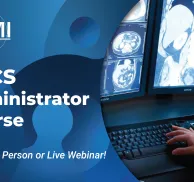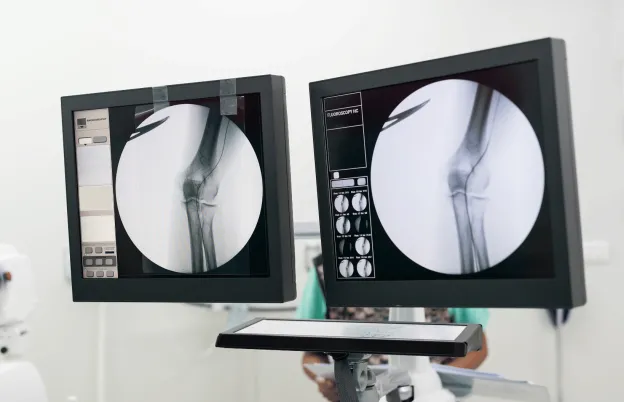
Digital Imaging: New Challenges - New Solutions
About this Program
Now that digital medical imaging has been in place for nearly a generation, we are seeing its impact on diagnostic medicine. This webinar explores the latest in digital medical imaging, helping you adapt to ongoing changes. You'll learn about evolving technologies and the challenges and opportunities for technologists in this digital revolution.
This course will take an in-depth look at a new digital exposure paradigm to prepare you for the changes that continue to unfold. In the analysis, we will look into the various evolving technologies that are fostering this change in thinking. Technologists will have a new set of challenges as this digital revolution continues, and our discussion will look at the opportunities to redefine this great profession.
Educational Objectives
Upon completion of this session, the participant should be able to:
- Identify significant technological advances that have occurred in diagnostic medical imaging over the past decades
- Analyze the current radiation exposure/image quality paradigm
- Suggest modifications to the present-day exposure technique paradigm, to improve its relevancy in a digital world
- Compare and contrast emerging digital technologies as to clinical utility
. - Suggest strategies to improve market value of medical imaging technologist
- Analyze digital radiographic images using clinical image benchmarks
Schedule
What this course will cover
The Digital Evolution in Diagnostic Medicine
- Why we are where we are
- Comparison to societal trends
- Paradigms-What are they?
- Technological paradigm shifts in society
Review of Digital Imaging Transformation
- Analog to Digital movement- What it did for the radiologist
- Impact on medical imaging personnel
- Examples of obsolete technologies due to digital
Concept of Electronic Data Sets
- Operation of digital detectors and energy accumulation
- Data set processing
- Signal and signal characteristics
- Image noise and its practical assessment
- Exposure Indicators (EI#’s) and how to use them
Current State of Digital Imaging in Radiology
- Direct vs. Indirect DR
- Detector Speeds and Exposure
- Dynamic Digital Receptor (DDR)
- Higher Resolution Panels
- Exposure Indices, Deviation Indices, ALARA Compliance
- ASRT Practice Standards and Digital Imaging
Examples of Technologies/Practices That “Just Don’t Fit Any Longer”
- Computed Radiography and dose inefficiencies
- kVp values
- Image Quality Assessment Methods
- Distances
- Filtration
Redefining the Profession
- Proposed New Digital Imaging Quality and Exposure Paradigm
- CC Cameras and Patient Photos as Radiologist Aid
- Artificial Intelligence and the radiographer
- Radiographer as a Patient Advocate and Radiation “Expert”
Radiologist Image Expectations
- Clinical image benchmarks for image quality assessment
- Low Contrast Resolution (LCR)
- DR detectors and grids
- DR and the role of distances
- Temporal Resolution (TR)
- Definition
- TR and its clinical value
- TR and clinical examples
- TR and equipment specifications
New Digital Detector Technologies
- Digital Tomosynthesis (DT) and DR detectors
- The role of positioning and views
- Impact upon part positioning
- DT and clinical utility
- Dynamic Digital Receptors (DDR)
- Basic operation
- Clinical utility
- Digital Detectors and SNR and Exposure Duration
- Comparison to AEC
- Assurance of image quality based upon SNR
Audience
Who should attend?
- Radiologic Technologists
- Medical Imaging Specialists
- Educators
- Vendor Personnel
Program Faculty
Meet your presenter(s)

Randy Griswold
MPA, RT(R)
Randy has been in the medical imaging profession for over 40 years as an educator, sales and marketing professional and consultant. Currently he is a contributing author and medical imaging consultant. Prior to that, he was the Director of Sales and Marketing for a Midwest distributor of digital medical imaging products. His collective experiences as an educator include being the Program Director for Bellin College, School of Radiologic Sciences and their BSRS program. He was instrumental in transforming their two-year certificate program to a four-year, accredited BSRS degree program.
Randy has 23 years of experience in radiology capital equipment sales, service and support including digital imaging, and has completed his graduate work in Public Service Administration with an emphasis in Health Care Administration and Medical Imaging Marketing. He is a past president of the Wisconsin Association of Educators in Radiologic Technology (WAERT) and the Wisconsin Society of Radiologic Technologists (WSRT) as well as being a Fellow. His passion for teaching is focused on helping technologists understand the importance of obtaining good quality images for diagnosis, in a fashion that uses the skills and techniques of radiologist interpretation.
Credits
Accredited training programs

ASRT Category A
This program provides 6.75 hour(s) of Category A continuing education credit for radiologic technologists approved by ASRT and recognized by the ARRT® and various licensure states. Category A credit is also recognized for CE credit in Canada. You must attend the entire program to receive your certificate of completion.
Tuition

| Audience | Price | Early Price | Member Price | Member Early Price |
|---|---|---|---|---|
| Technologist | $149.00 | $143.00 | $135.00 | $129.00 |
Early Pricing Guidelines
Qualifying 'Early' registrations must be made at least 4 days in advance for the program.
Cancellation Policy
Webinars less than 8 hours of credit
Refunds, minus a $15 processing fee, will be granted for cancellations received at least 3 days prior to the program. Cancellations received within 3 days of the webinar will receive a credit toward a future MTMI program, minus the $15 processing fee. No refunds will be made after the webinar starts. MTMI reserves the right to cancel any scheduled program because of low advance registration or other reasons. MTMI’s liability is limited to a refund of any program tuition paid. WEBINAR ATTENDEES that cannot log in due to unsolvable technical issues beyond their control will be eligible for a full refund.












